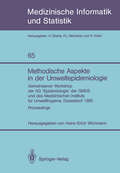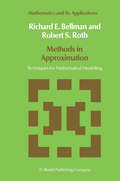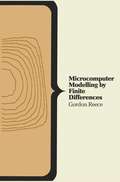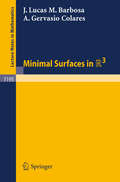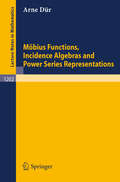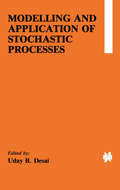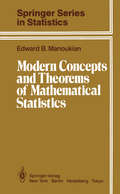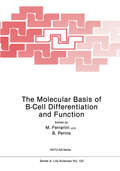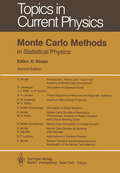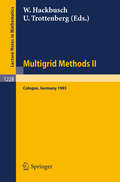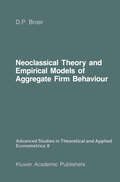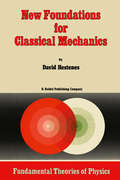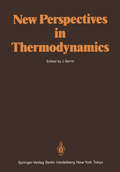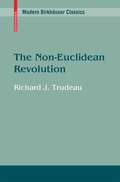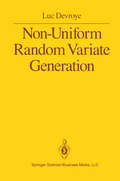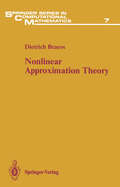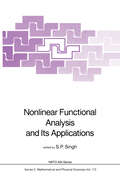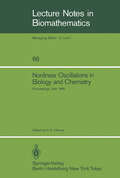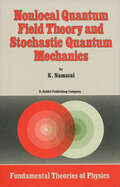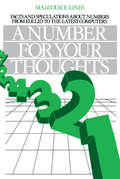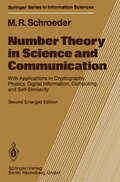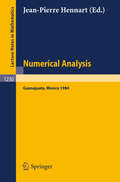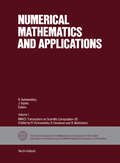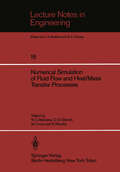- Table View
- List View
Methodische Aspekte in der Umweltepidemiologie: Gemeinsamer Workshop der AG ‘Epidemiologie’ der GMDS und des Medizinischen Instituts für Umwelthygiene, Düsseldorf, 1985 (Medizinische Informatik, Biometrie und Epidemiologie #65)
by Heinz-Erich WichmannMethods in Approximation: Techniques for Mathematical Modelling (Mathematics and Its Applications #26)
by N.D. Bellman R.S. RothApproach your problems from the right end It isn't that they can't see the solution. It is and begin with the answers. Then one day, that they can't see the problem. perhaps you will find the final question. G. K. Chesterton. The Scandal of Father 'The Hermit Clad in Crane Feathers' in R. Brown 'The point of a Pin'. van Gulik's The Chinese Maze Murders. Growing specialization and diversification have brought a host of monographs and textbooks on increasingly specialized topics. However, the "tree" of knowledge of mathematics and related fields does not grow only by putting forth new branches. It also happens, quite often in fact, that branches which were thought to be completely disparate are suddenly seen to be related. Further, the kind and level of sophistication of mathematics applied in various sciences has changed drastically in recent years: measure theory is used (non trivially) in regional and theoretical economics; algebraic geometry interacts with physics; the Minkowsky lemma, coding theory and the structure of water meet one another in packing and covering theory; quantum fields, crystal defects and mathematical programming profit from homotopy theory; Lie algebras are relevant to filtering; and prediction and electrical engineering can use Stein spaces. And in addition to this there are such new emerging subdisciplines as "experimental mathematics", "CFD", "completely integrable systems", "chaos, synergetics and large-scale order", which are almost impossible to fit into the existing classification schemes. They draw upon widely different sections of mathematics.
Minimal Surfaces in R 3 (Lecture Notes in Mathematics #1195)
by J.Lucas M. Barbosa A.Gervasio ColaresMöbius Functions, Incidence Algebras and Power Series Representations (Lecture Notes in Mathematics #1202)
by Arne DürModelling and Application of Stochastic Processes
by Uday B. DesaiThe subject of modelling and application of stochastic processes is too vast to be exhausted in a single volume. In this book, attention is focused on a small subset of this vast subject. The primary emphasis is on realization and approximation of stochastic systems. Recently there has been considerable interest in the stochastic realization problem, and hence, an attempt has been made here to collect in one place some of the more recent approaches and algorithms for solving the stochastic realiza tion problem. Various different approaches for realizing linear minimum-phase systems, linear nonminimum-phase systems, and bilinear systems are presented. These approaches range from time-domain methods to spectral-domain methods. An overview of the chapter contents briefly describes these approaches. Also, in most of these chapters special attention is given to the problem of developing numerically ef ficient algorithms for obtaining reduced-order (approximate) stochastic realizations. On the application side, chapters on use of Markov random fields for modelling and analyzing image signals, use of complementary models for the smoothing problem with missing data, and nonlinear estimation are included. Chapter 1 by Klein and Dickinson develops the nested orthogonal state space realization for ARMA processes. As suggested by the name, nested orthogonal realizations possess two key properties; (i) the state variables are orthogonal, and (ii) the system matrices for the (n + l)st order realization contain as their "upper" n-th order blocks the system matrices from the n-th order realization (nesting property).
Modern Concepts and Theorems of Mathematical Statistics (Springer Series in Statistics)
by Edward B. ManoukianWith the rapid progress and development of mathematical statistical methods, it is becoming more and more important for the student, the in structor, and the researcher in this field to have at their disposal a quick, comprehensive, and compact reference source on a very wide range of the field of modern mathematical statistics. This book is an attempt to fulfill this need and is encyclopedic in nature. It is a useful reference for almost every learner involved with mathematical statistics at any level, and may supple ment any textbook on the subject. As the primary audience of this book, we have in mind the beginning busy graduate student who finds it difficult to master basic modern concepts by an examination of a limited number of existing textbooks. To make the book more accessible to a wide range of readers I have kept the mathematical language at a level suitable for those who have had only an introductory undergraduate course on probability and statistics, and basic courses in calculus and linear algebra. No sacrifice, how ever, is made to dispense with rigor. In stating theorems I have not always done so under the weakest possible conditions. This allows the reader to readily verify if such conditions are indeed satisfied in most applications given in modern graduate courses without being lost in extra unnecessary mathematical intricacies. The book is not a mere dictionary of mathematical statistical terms.
The Molecular Basis of B-Cell Differentiation and Function (Nato Science Series A: #123)
by M. Ferrarini Benventuto PernisThe progress in protein and nucleic acid chemistry together with improvements of the previously employed tissue culture techniques have led to the solution of problems such as that of the generation of antibody diversity or of the molecular structure of T and B cell membrane receptor for antigen which had challenged the past generations of immunologists. Thanks to this progress an impressive amount of knowledge has been accumulated on certain cell types that were relatively "mysterious" until recently. The B lymphocyte represents a typical example of such a cell. With these considerations in mind, we have started to organize a NATO summer school on "The molecular basis of B cell differentation and function" that had the specific aim of bringing up to date a selected number of young investigators. During the course, held in Santa Margheri ta Ligure, October 1-11, 1985 it became apparent that rather than a formal school we had organized an informal series of Workshops where both the Faculty members and the participants were discussing their own data in addition to reviewing the general progress in the field. The deep commi ttment of everyone to his research subj ect and the enthusiasm had caused this very successful change in the shape of the course. At the end we asked the members of the Faculty and the participants to write a summary of their data and of their point of view on selected subj ect s.
Monte Carlo Methods in Statistical Physics (Topics in Current Physics #7)
by K. Binder D. M. Ceperley J. P. Hansen M. H. Kalos D. P. Landau D. Levesque H. Müller-Krumbhaar D. Stauffer J. J. WeisIn the seven years since this volume first appeared. there has been an enormous expansion of the range of problems to which Monte Carlo computer simulation methods have been applied. This fact has already led to the addition of a companion volume ("Applications of the Monte Carlo Method in Statistical Physics", Topics in Current Physics. Vol . 36), edited in 1984, to this book. But the field continues to develop further; rapid progress is being made with respect to the implementation of Monte Carlo algorithms, the construction of special-purpose computers dedicated to exe cute Monte Carlo programs, and new methods to analyze the "data" generated by these programs. Brief descriptions of these and other developments, together with numerous addi tional references, are included in a new chapter , "Recent Trends in Monte Carlo Simulations" , which has been written for this second edition. Typographical correc tions have been made and fuller references given where appropriate, but otherwise the layout and contents of the other chapters are left unchanged. Thus this book, together with its companion volume mentioned above, gives a fairly complete and up to-date review of the field. It is hoped that the reduced price of this paperback edition will make it accessible to a wide range of scientists and students in the fields to which it is relevant: theoretical phYSics and physical chemistry , con densed-matter physics and materials science, computational physics and applied mathematics, etc.
Multigrid Methods II: Proceedings of the 2nd European Conference on Multigrid Methods Held at Cologne, October 1-4, 1985 (Lecture Notes in Mathematics #1228)
by Wolfgang Hackbusch Ulrich TrottenbergNeoclassical Theory and Empirical Models of Aggregate Firm Behaviour (Advanced Studies in Theoretical and Applied Econometrics #8)
by D. Peter BroerNew Foundations for Classical Mechanics (Fundamental Theories of Physics #15)
by D. HestenesThis is a textbook on classical mechanics at the intermediate level, but its main purpose is to serve as an introduction to a new mathematical language for physics called geometric algebra. Mechanics is most commonly formulated today in terms of the vector algebra developed by the American physicist J. Willard Gibbs, but for some applications of mechanics the algebra of complex numbers is more efficient than vector algebra, while in other applica tions matrix algebra works better. Geometric algebra integrates all these algebraic systems into a coherent mathematical language which not only retains the advantages of each special algebra but possesses powerful new capabilities. This book covers the fairly standard material for a course on the mechanics of particles and rigid bodies. However, it will be seen that geometric algebra brings new insights into the treatment of nearly every topic and produces simplifications that move the subject quickly to advanced levels. That has made it possible in this book to carry the treatment of two major topics in mechanics well beyond the level of other textbooks. A few words are in order about the unique treatment of these two topics, namely, rotational dynamics and celestial mechanics.
New Perspectives in Thermodynamics
by James SerrinThe material included in this book was first presented in a series of lectures de livered at the University of Minnesota in June 1983 in connection with the con ference "Thermodynamics and Phase Transitions". This conference was one of the principal events in the first year of operation of the Institute for Mathematics and its Applications (lMA) at the University of Minnesota. The Institute was founded under the auspices of the National Science Foun dation of the United States and the University of Minnesota and is devoted to strengthening and fostering the relation of mathematics with its various applica tions to problems of the real world. The present volume constitutes an important element in the continuing pub lication program of the Ipstitute. Previous publications in this program have ap peared as lecture notes in the well-known Springer series, and future ones will be part of a new series "IMA Volumes in Applied Mathematics". Preface Until recently it was believed that thermodynamics could be given a rigorous foundation only in certain restricted circumstances, particularly those involving reversible and quasi-static processes. More general situations, commonly arising in continuum theories, have therefore been treated on the assumption that inter nal energy, entropy and absolute temperature are a priori given quantities, or have been dealt with on a more or less ad hoc basis, with emphasis for example on various types of variational formulations and maximization rules.
The Non-Euclidean Revolution
by Richard J. TrudeauRichard Trudeau confronts the fundamental question of truth and its representation through mathematical models in The Non-Euclidean Revolution. First, the author analyzes geometry in its historical and philosophical setting; second, he examines a revolution every bit as significant as the Copernican revolution in astronomy and the Darwinian revolution in biology; third, on the most speculative level, he questions the possibility of absolute knowledge of the world. A portion of the book won the Pólya Prize, a distinguished award from the Mathematical Association of America.
Nonlinear Approximation Theory (Springer Series in Computational Mathematics #7)
by Dietrich BraessThe first investigations of nonlinear approximation problems were made by P.L. Chebyshev in the last century, and the entire theory of uniform approxima tion is strongly connected with his name. By making use of his ideas, the theories of best uniform approximation by rational functions and by polynomials were developed over the years in an almost unified framework. The difference between linear and rational approximation and its implications first became apparent in the 1960's. At roughly the same time other approaches to nonlinear approximation were also developed. The use of new tools, such as nonlinear functional analysis and topological methods, showed that linearization is not sufficient for a complete treatment of nonlinear families. In particular, the application of global analysis and the consideration of flows on the family of approximating functions intro duced ideas which were previously unknown in approximation theory. These were and still are important in many branches of analysis. On the other hand, methods developed for nonlinear approximation prob lems can often be successfully applied to problems which belong to or arise from linear approximation. An important example is the solution of moment problems via rational approximation. Best quadrature formulae or the search for best linear spaces often leads to the consideration of spline functions with free nodes. The most famous problem of this kind, namely best interpolation by poly nomials, is treated in the appendix of this book.
Nonlinear Functional Analysis and Its Applications (Nato Science Series C: #173)
by S. P. SinghA NATO Advanced Study Institute on Nonlinear Functional Analysis and Its Applications was held in Hotel Villa del Mare, Maratea, It.a1y during April 22 - May 3, 1985. This volume consists of the Proceedings of the Institute. These Proceedings include the invited lectures and contributed papers given during the Institute. The papers have been refereed. The aim of these lectures was to bring together recent and up-to-date development of the subject, and to give directions for future research. The main topics covered include: degree and generalized degree theory, results related to Hamiltonian Systems, Fixed Point theory, linear and nonlinear Differential and Partial Differential Equations, Theory of Nielsen Numbers, and applications to Dynamical Systems, Bifurcation Theory, Hamiltonian Systems, Minimax Theory, Heat Equations, Pendulum Equation, Nonlinear Boundary Value Problems, and Dirichlet and Neumann problems for elliptic equations and the periodic Dirichlet problem for semilinear beam equations. I express my sincere thanks to Professors F. E. Browder, R. Conti, A. Do1d, D. E. Edmunds and J. Mawhin members of the Advisory Committee.
Nonlinear Oscillations in Biology and Chemistry: Proceedings of a meeting held at the University of Utah, May 9–11, 1985 (Lecture Notes in Biomathematics #66)
by Hans G. OthmerThis volume contains the proceedings of a meeting entitled 'Nonlinear Oscillations in Biology and Chemistry', which was held at the University of Utah May 9-11,1985. The papers fall into four major categories: (i) those that deal with biological problems, particularly problems arising in cell biology, (ii) those that deal with chemical systems, (iii) those that treat problems which arise in neurophysiology, and (iv), those whose primary emphasis is on more general models and the mathematical techniques involved in their analysis. Except for the paper by Auchmuty, all are based on talks given at the meeting. The diversity of papers gives some indication of the scope of the meeting, but the printed word conveys neither the degree of interaction between the participants nor the intellectual sparks generated by that interaction. The meeting was made possible by the financial support of the Department of Mathe matics of the University of Utah. I am indebted to Ms. Toni Bunker of the Department of Mathematics for her very able assistance on all manner of details associated with the organization of the meeting. Finally, a word of thanks to all participants for their con tributions to the success of the meeting, and to the contributors to this volume for their efforts in preparing their manuscripts.
Nonlocal Quantum Field Theory and Stochastic Quantum Mechanics (Fundamental Theories of Physics #13)
by K.H. Namsraiover this stochastic space-time leads to the non local fields considered by G. V. Efimov. In other words, stochasticity of space-time (after being averaged on a large scale) as a self-memory makes the theory nonlocal. This allows one to consider in a unified way the effect of stochasticity (or nonlocality) in all physical processes. Moreover, the universal character of this hypothesis of space-time at small distances enables us to re-interpret the dynamics of stochastic particles and to study some important problems of the theory of stochastic processes [such as the relativistic description of diffusion, Feynman type processes, and the problem of the origin of self-turbulence in the motion of free particles within nonlinear (stochastic) mechanics]. In this direction our approach (Part II) may be useful in recent developments of the stochastic interpretation of quantum mechanics and fields due to E. Nelson, D. Kershaw, I. Fenyes, F. Guerra, de la Pena-Auerbach, J. -P. Vigier, M. Davidson, and others. In particular, as shown by N. Cufaro Petroni and J. -P. Vigier, within the discussed approach, a causal action-at-distance interpretation of a series of experiments by A. Aspect and his co-workers indicating a possible non locality property of quantum mechanics, may also be obtained. Aspect's results have recently inspired a great interest in different nonlocal theories and models devoted to an understanding of the implications of this nonlocality. This book consists of two parts.
A Number for your Thoughts: Facts and Speculations About Numbers from Euclid to the Latest Computers
by M. E. LinesWhy do we count the way we do? What is a prime number or a friendly, perfect, or weird one? How many are there and who has found the largest yet known? What is the Baffling Law of Benford and can you really believe it? Do most numbers you meet in every day life really begin with a 1, 2, or 3? What is so special about 6174? Can cubes, as well as squares, be magic? What secrets lie hidden in decimals? How do we count the infinite, and is one infinity really larger than another? These and many other fascinating questions about the familiar 1, 2, and 3 are collected in this adventure into the world of numbers. Both entertaining and informative, A Number for Your Thoughts: Facts and Speculations about Numbers from Euclid to the Latest Computers contains a collection of the most interesting facts and speculations about numbers from the time of Euclid to the most recent computer research. Requiring little or no prior knowledge of mathematics, the book takes the reader from the origins of counting to number problems that have baffled the world's greatest experts for centuries, and from the simplest notions of elementary number properties all the way to counting the infinite.
A Number for your Thoughts: Facts and Speculations About Numbers from Euclid to the Latest Computers
by M. E. LinesWhy do we count the way we do? What is a prime number or a friendly, perfect, or weird one? How many are there and who has found the largest yet known? What is the Baffling Law of Benford and can you really believe it? Do most numbers you meet in every day life really begin with a 1, 2, or 3? What is so special about 6174? Can cubes, as well as squares, be magic? What secrets lie hidden in decimals? How do we count the infinite, and is one infinity really larger than another? These and many other fascinating questions about the familiar 1, 2, and 3 are collected in this adventure into the world of numbers. Both entertaining and informative, A Number for Your Thoughts: Facts and Speculations about Numbers from Euclid to the Latest Computers contains a collection of the most interesting facts and speculations about numbers from the time of Euclid to the most recent computer research. Requiring little or no prior knowledge of mathematics, the book takes the reader from the origins of counting to number problems that have baffled the world's greatest experts for centuries, and from the simplest notions of elementary number properties all the way to counting the infinite.
Number Theory in Science and Communication: With Applications in Cryptography, Physics, Digital Information, Computing, and Self-Similarity (Springer Series in Information Sciences #7)
by Manfred R. Schroeder"Beauty is the first test: there is no permanent place in the world for ugly mathematics. " - G. H. Hardy Number theory has been considered since time immemorial to be the very paradigm of pure (some would say useless) mathematics. In fact, the Chinese characters for mathematics are Number Science. "Mathematics is the queen of sciences - and number theory is the queen of mathematics," according to Carl Friedrich Gauss, the lifelong Wunderkind, who himself enjoyed the epithet "Princeps Mathematicorum. " What could be more beautiful than a deep, satisfying relation between whole numbers. (One is almost tempted to call them wholesome numbers') In fact, it is hard to come up with a more appropriate designation than their learned name: the integers - meaning the "untouched ones". How high they rank, in the realms of pure thought and aesthetics, above their lesser brethren: the real and complex number- whose first names virtually exude unsavory involvement with the complex realities of everyday life! Yet, as we shall see in this book, the theory of integers can provide totally unexpected answers to real-world problems. In fact, discrete mathematics is taking on an ever more important role. If nothing else, the advent of the digital computer and digital communication has seen to that. But even earlier, in physics the emergence of quantum mechanics and discrete elementary particles put a premium on the methods and, indeed, the spirit of discrete mathematics.
Numerical Analysis: Proceedings of the Fourth IIMAS Workshop held at Guanajuato, Mexico, July 1984 (Lecture Notes in Mathematics #1230)
by Jean-Pierre HennartNumerical Mathematics and Applications (IMACS Transactions on Scientific Computation - 85 #Volume 1)
by J. Vignes R. VichnevetskyNumerical Mathematics and Applications
Numerical Simulation of Fluid Flow and Heat/Mass Transfer Processes (Lecture Notes in Engineering #18)
by N. C. Markatos D. G. Tatchell M. Cross N. RhodesComputational fluid flow is not an easy subject. Not only is the mathematical representation of physico-chemical hydrodynamics complex, but the accurate numerical solution of the resulting equations has challenged many numerate scientists and engineers over the past two decades. The modelling of physical phenomena and testing of new numerical schemes has been aided in the last 10 years or so by a number of basic fluid flow programs (MAC, TEACH, 2-E-FIX, GENMIX, etc). However, in 1981 a program (perhaps more precisely, a software product) called PHOENICS was released that was then (and still remains) arguably, the most powerful computational tool in the whole area of endeavour surrounding fluid dynamics. The aim of PHOENICS is to provide a framework for the modelling of complex processes involving fluid flow, heat transfer and chemical reactions. PHOENICS has now been is use for four years by a wide range of users across the world. It was thus perceived as useful to provide a forum for PHOENICS users to share their experiences in trying to address a wide range of problems. So it was that the First International PHOENICS Users Conference was conceived and planned for September 1985. The location, at the Dartford Campus of Thames Polytechnic, in the event, proved to be an ideal site, encouraging substantial interaction between the participants.
